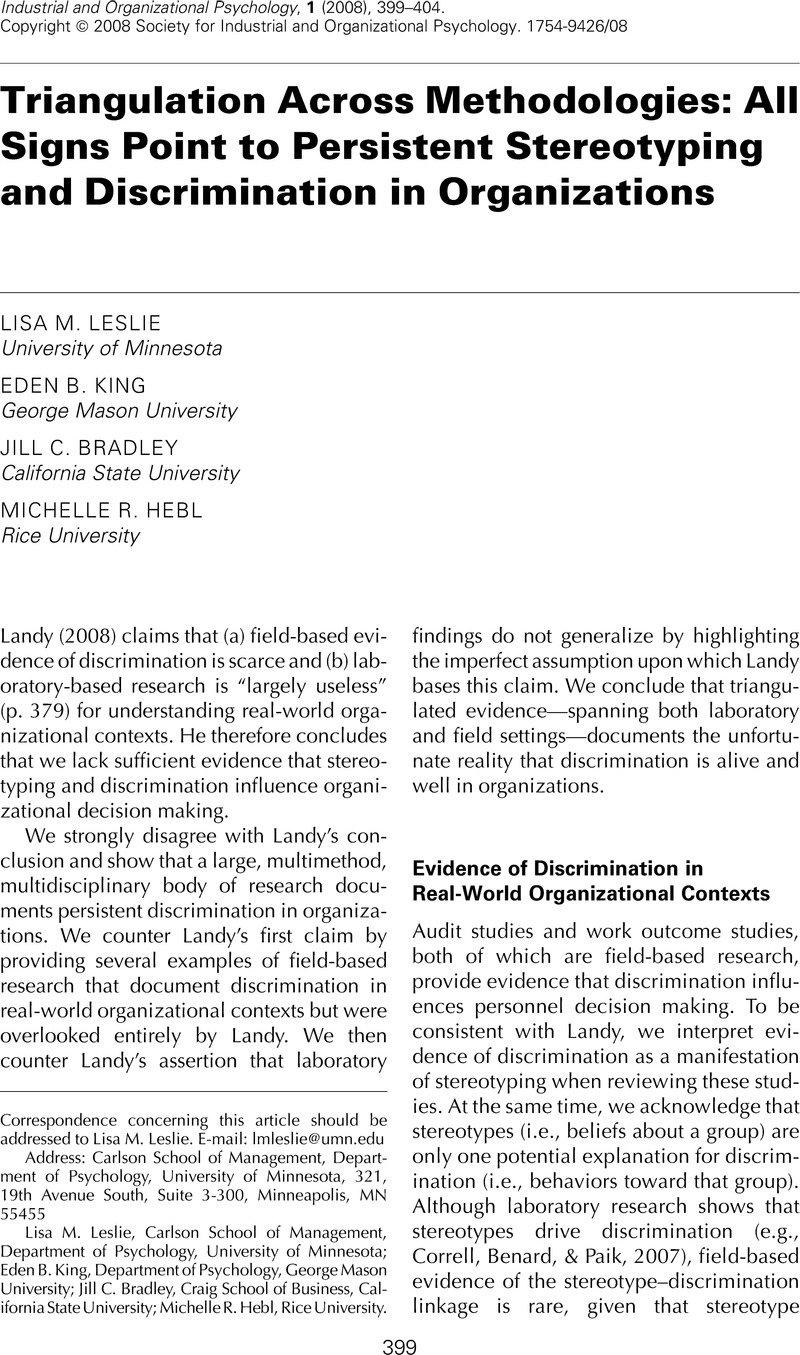Crossref Citations
This article has been cited by the following publications. This list is generated based on data provided by Crossref.
Landy, Frank J.
2008.
Stereotyping, Implicit Association Theory, and Personnel Decisions: I Guess We Will Just Have to Agree to Disagree.
Industrial and Organizational Psychology,
Vol. 1,
Issue. 4,
p.
444.
Greenwald, Anthony G.
2008.
Landy Is Correct: Stereotyping Can Be Moderated by Individuating the Out-Group and by Being Accountable.
Industrial and Organizational Psychology,
Vol. 1,
Issue. 4,
p.
430.
Dietz, Joerg
and
Dietz, Joerg
2010.
Introduction to the special issue on employment discrimination against immigrants.
Journal of Managerial Psychology,
Vol. 25,
Issue. 2,
p.
104.
Leslie, Lisa M.
and
Manchester, Colleen F.
2011.
Work–Family Conflict Is a Social Issue Not a Women's Issue.
Industrial and Organizational Psychology,
Vol. 4,
Issue. 3,
p.
414.
Wanberg, Connie R.
2012.
The Individual Experience of Unemployment.
Annual Review of Psychology,
Vol. 63,
Issue. 1,
p.
369.
Fisher, Emily L.
and
Borgida, Eugene
2012.
Intergroup Disparities and Implicit Bias: A Commentary.
Journal of Social Issues,
Vol. 68,
Issue. 2,
p.
385.
Hebl, Michelle R.
and
Avery, Derek R.
2012.
Handbook of Psychology, Second Edition.
Truxillo, Donald M.
McCune, Elizabeth A.
Bertolino, Marilena
and
Fraccaroli, Franco
2012.
Perceptions of Older Versus Younger Workers in Terms of Big Five Facets, Proactive Personality, Cognitive Ability, and Job Performance.
Journal of Applied Social Psychology,
Vol. 42,
Issue. 11,
p.
2607.
Li Kusterer, Hanna
Lindholm, Torun
and
Montgomery, Henry
2013.
Gender typing in stereotypes and evaluations of actual managers.
Journal of Managerial Psychology,
Vol. 28,
Issue. 5,
p.
561.
Leslie, Lisa M.
Mayer, David M.
and
Kravitz, David A.
2014.
The Stigma of Affirmative Action: A Stereotyping-Based Theory and Meta-Analytic Test of the Consequences for Performance.
Academy of Management Journal,
Vol. 57,
Issue. 4,
p.
964.
Cuadrado, Isabel
García‐Ael, Cristina
and
Molero, Fernando
2015.
Gender‐typing of leadership: Evaluations of real and ideal managers.
Scandinavian Journal of Psychology,
Vol. 56,
Issue. 2,
p.
236.
Dietz, Joerg
Kleinlogel, Emmanuelle P.
and
Chui, Celia W. S.
2015.
Wiley Encyclopedia of Management.
p.
1.
Waung, Marie
Hymes, Robert
Beatty, Joy E.
and
McAuslan, Pam
2015.
Self‐promotion Statements in Video Resumes: Frequency, intensity, and gender effects on job applicant evaluation.
International Journal of Selection and Assessment,
Vol. 23,
Issue. 4,
p.
345.
Bradley-Geist, Jill C.
Rivera, Ivy
and
Geringer, Susan D.
2015.
The Collateral Damage of Ambient Sexism: Observing Sexism Impacts Bystander Self-Esteem and Career Aspirations.
Sex Roles,
Vol. 73,
Issue. 1-2,
p.
29.
King, Eden B.
Rogelberg, Steven G.
Hebl, Michelle R.
Braddy, Phillip W.
Shanock, Linda R.
Doerer, Sharon C.
and
McDowell-Larsen, Sharon
2016.
Waistlines and Ratings of Executives: Does Executive Status Overcome Obesity Stigma?.
Human Resource Management,
Vol. 55,
Issue. 2,
p.
283.
Bono, Joyce E.
Braddy, Phillip W.
Liu, Yihao
Gilbert, Elisabeth K.
Fleenor, John W.
Quast, Louis N.
and
Center, Bruce A.
2017.
Dropped on the way to the top: Gender and managerial derailment.
Personnel Psychology,
Vol. 70,
Issue. 4,
p.
729.
Leslie, Lisa M.
Manchester, Colleen Flaherty
and
Dahm, Patricia C.
2017.
Why and When Does the Gender Gap Reverse? Diversity Goals and the Pay Premium for High Potential Women.
Academy of Management Journal,
Vol. 60,
Issue. 2,
p.
402.
de Kock, François S.
and
Hauptfleisch, Daniël B.
2018.
Reducing Racial Similarity Bias in Interviews by Increasing Structure: A Quasi-Experiment Using Multilevel Analysis.
International Perspectives in Psychology,
Vol. 7,
Issue. 3,
p.
137.
Rubin, Ellen V.
and
Edwards, Amani
2020.
The performance of performance appraisal systems: understanding the linkage between appraisal structure and appraisal discrimination complaints.
The International Journal of Human Resource Management,
Vol. 31,
Issue. 15,
p.
1938.
Schaefer, Hillary S.
Bigelman, Kevin A.
Gist, Nicholas H.
and
Lerner, Richard M.
2021.
But how many push-ups can she do? The influence of sexism on peer ratings in a military setting.
Personality and Individual Differences,
Vol. 177,
Issue. ,
p.
110805.





